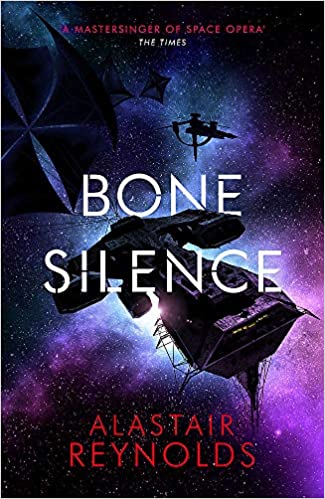
Bone Silence concludes the trilogy about the Ness sisters who ran away from home and became space pirates…and a lot more. I’m a fan of Alastair Reynolds’s space operas, but this Young Adult trilogy fell flat with me. I thought the first book, Revenger (you can read my review here), was the strongest book of the three. It introduced the reader to the feisty Ness sisters, Arafura and Adrana, and their AI, Paladin. The second novel, Shadow Captain, ratcheted up the violence with some bloody battles in space (you can read my review here). This third volume, at 603 pages, pretty much ties up all the loose ends of a story that encompasses millions of years.
A number of mysteries, disappearances, reappearances, and skullduggery swirl around the plot of Bone Silence. There are a couple of deus ex machina moments that might annoy some readers. But the scope of the 20,000 worlds of the Congregation lends itself to grand moments. If you’re looking for a diverting and mildly entertaining YA space opera trilogy, Alastair Reynolds provides one with these books. Just make sure you don’t set the bar too high. GRADE: B
A 603-page book for YA’s, who don’t have an attention span of 20 seconds! That’s confidence!
Bob, I’m amazed at the number of Young Adult books that weigh in at 500+ pages: Rick Riodan’s Percy Jackson series are all Big Fat Books.
I’m a fan of Reynolds but didn’t care for the first volume in this series so I didn’t read any farther. Clearly young adult the first novel was published as adult as far as I can recall.
Steve, my disaffection with the Ness Sisters grew book by book. Alastair Reynolds relies on some far-fetched events to move the plots along.
Too many books, too little time. I’ll skip this one too.
Jeff, I do like the cover artwork on BONE SILENCE.
As the time when I was an active reader of SF recedes further and further into the past (30+ years now) it’s gotten to the point where none of the current names mean anything at all. When you feature those Best SF of this or that year, the TOC generally includes writers I actually read and, in many cases, remember fondly. Now and then, but increasingly rarely, names I remember reading will pop up in a current context, and I think “Oh, he/she is still active?”. I do remember reading Gregory Benford, Larry Niven, Kim Stanley Robinson, and a few others, but SF has mostly become an exercise in nostalgia.
Michael, I have a Kim Stanley Robinson collection in my On Deck Circle. It’s been a while since I read any Gregory Benford.
When we were all kids, were there any books classified as YA? I remember going from Nancy Drew to Agatha Christie pretty much. What would have been a YA book in 1960 when I was 12.
I did the same thing, Patti. Went from the N. Drew, Dana Girls, Judy Bolton to Mary Stewart, Victoria Holt, Agatha Christie, non of which were YA.
We lived in a simpler time, so maybe as the world grew more complex and weird, authors and publishers felt the need to bridge the gap between children and adults, kind of easing kids into adulthood.
I think they just called them “juvenile” fiction then, Patti, at least for adventure and science fiction. The Nancy Drew and Hardy Boys books would have been tagged YA these days.
Patti, Robert A. Heinlein wrote a series of SF novels for “juveniles.” Juveniles morphed into Young Adult novels. From the mixed-up files of Mrs. Basil E. Frankweiler by
E. L Konigsburg, The black cauldron. by Lloyd Alexander, and A wrinkle in time by Madeleine L’Engle would be examples of YA novels from the 1960s.
If you look at the Newberry Award winners, they were books I would have read at maybe ten and also they are very serious historical type books mostly.
Patti, you’re right about the Newberry Awards favoring historical fiction for Young Adults. They pushed didactic fiction back then.
Clearly today’s YAs are not so much about stuffing mythology or history into young minds. They seem to be more fun.
Patti, the YA fiction market today features more female characters and creative situations than the YA novels from the Sixties.
Patti’s question got me thinking, and the only books considered YA (although I don’t think it was called that) that I recall from that period were SF, most prominently Heinlein and Andre Norton.
I have always thought of YA as being books for early teens and juveniles as pre teen books. YA didn’t exist when I was a kid. You had Heinelin. Hardy Bors. Black Stallion books but I always considered them pre teen books.
Michael, Heinlein and Andre Norton wrote SF for the YA market. But, there were some YA fantasy novels, too. And, if you count the Hardy Boys and Nancy Drew, there were plenty of YA mysteries.
William Campbell Gault quit writing adult mysteries for twenty years because he was doing so well writing sports fiction for teenage boys.
Jeff, I forgot all about William Campbell Gault’s Young Adult novels. I read a few of them when I was a teenager and I have five or six copies that I found over the years. Lots of fast cars!
Reynolds not being a favorite, I already would have skipped this one.
@ Michael: I’m reading and rereading old SF in anthologies from the Fifties and Sixties, and enjoying it.
Rick, I just spent a year reading THE GREAT SF STORIES series that collected the “best” of the 1950s. I’ve only got a few volumes left to read before I wrap that project up.